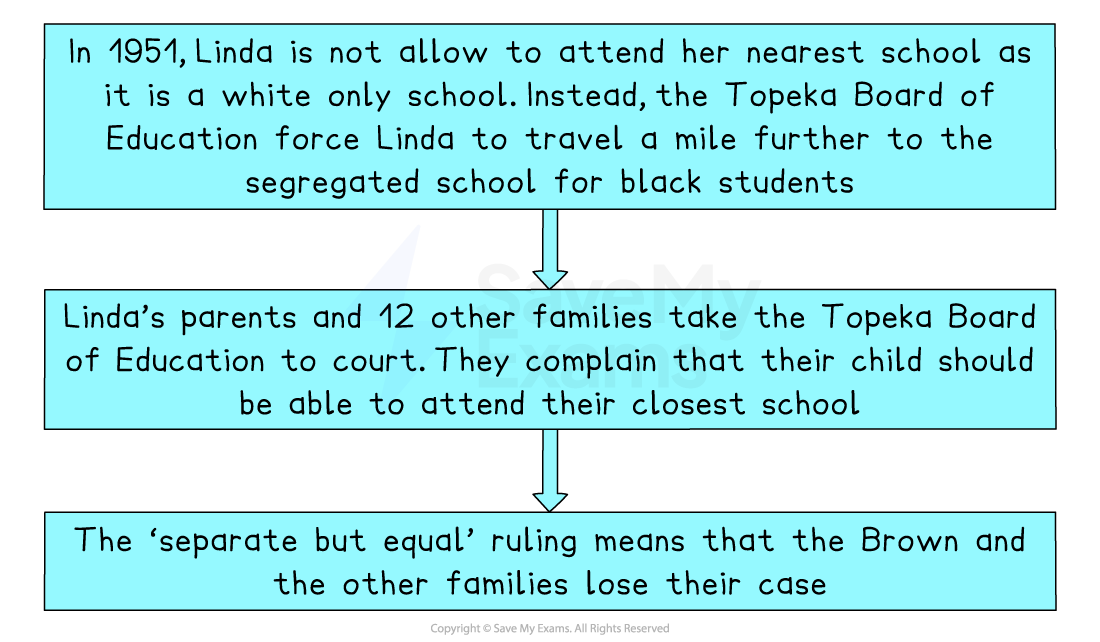Progress in Education-Brown vs Topeka, 1954 (AQA GCSE History): Revision Note
Exam code: 8145
How did Brown vs Topeka Progress Civil Rights in the USA? - Timeline & Summary

Brown vs Board of Education, Topeka, Kansas was a landmark Supreme Court case that played a crucial role in advancing civil rights in the USA. The case challenged the legality of racial segregation in public schools.
In 1954, the Supreme Court ruled that segregation in education was unequal and unfair. It proved that the "separate but equal" approach was unconstitutional for African-Americans. This decision marked a significant victory for the civil rights movement.
The impact of Brown vs Topeka went beyond just schools. The Supreme Court’s decision inspired activists and civil rights organisations to push for an end to segregation in public transportation and places like restaurants and cinemas. More people moved to challenge unfair employment laws and working standards.
The Impacts of Plessy vs Ferguson on Education
Plessy vs Ferguson (1896) stated that African-Americans had to have access to ‘separate but equal’ facilities to white Americans
In the 1950s, many schools were segregated
This meant that African-Americans children had to go to designated schools that only contained black students
Schools for African-Americans had less funding from the local government
Their facilities, classrooms and learning resources were of a lower standard than those in white-only schools
By the early 1950s, Southern state officials tried to improve segregated schools
By improving conditions, they hoped to avoid the desegregation of education
Who was Linda Brown?
In 1951, Linda Brown was a nine-year-old African-American student
She lived in Topeka, Kansas
Linda’s story became the centre of a key civil rights case against segregated schools


Brown vs Topeka, 1954
In 1952, the NAACP took on Linda’s case as well as four other desegregation cases to the US Supreme Court
They called the case Brown vs the Board of Education, Topeka, Kansas
The NAACP argued to the Supreme Court that:
Segregated schools made black children feel inferior
‘Separate but equal’ was unconstitutional as it went against the 14th Amendment
In December 1952, the Supreme Court voted to hear more legal advice on the case
They avoided making a ruling
The original judge trying the case died
His replacement was Earl Warren. He disagreed with segregation
How did the Brown vs Topeka case end?
On 17th May 1954, the Supreme Court ruled that:
The USA had changed since the Plessy vs Ferguson case
All US citizens should have a good education
The NAACP were right that segregated education was unconstitutional
It set no timeframe to desegregate schools
In May 1955, a second ruling on the case stated that desegregation should happen
“With all deliberate speed'
Short-Term Impact of Brown vs Topeka
Short-Term Impact of Brown vs Topeka
Positive short-term impacts | Negative short-term impacts |
|---|---|
‘Separate but equal’ could no longer justify segregation. Schools began to desegregate | The Supreme Court’s decision was too late for Linda Brown. She went to a junior high school. Junior high schools were already desegregated in Kansas |
Brown vs Topeka was a significant victory for the NAACP and the civil rights movement | Many white Americans reacted negatively to the ruling. The number of Ku Klux Klan (KKK) members increased. White Americans attacked black students at desegregated schools |
The Deep South reacted negatively to the ruling. The governor of Mississippi made a promise to keep segregation. Mississippi also created the White Citizens’ Council in July 1954. They used extreme violence to maintain segregation |
Examiner Tips and Tricks
Considering short- and long-term impacts is an important skill for AQA America, 1920-1973. You will be asked to do this when writing the 12-mark question. This is because you will have to consider which of the two listed factors had more of an impact on an aspect of US society. Thinking about short- and long-term importance will help you make judgements about which factor you believe is the most important
Long-Term Impact of Brown vs Topeka
Long-Term Impact of Brown vs Topeka
Positive long-term impacts | Negative long-term impacts |
|---|---|
Throughout the 1950s and 1960s, there was more pressure in the South to desegregate schools | Some white Americans moved away from areas where more African-Americans lived. This was to avoid desegregation |
The ruling motivated civil rights groups to target other desegregation campaigns | Black students and teachers faced racism and violent attacks in integrated schools. In addition, well-run Black-only schools were shut down. Students had to move to other schools and teachers lost their jobs |
Worked Example
In what ways did Brown vs the Board of Education, Topeka, Kansas (1954) affect the lives of African-Americans in the 1950s and 1960s?
[8 marks]
Answer:
One way that Brown vs the Board of Education, Topeka, Kansas (Brown vs Topeka) changed the lives of African-Americans was it created a negative reaction from white Americans in the South (1). When the US Supreme Court that segregated schools were unconstitutional in 1954 and 1955, some southern states promised to uphold segregation (1). This impacted the lives of African-Americans because it made their school experience incredibly dangerous. White students attacked black students and teachers in a protest against segregation. This affected their safety and their ability to work in this environment (1). Therefore, Brown vs Topeka had some negative impacts on the education available to African-Americans (1).
Examiner Tips and Tricks
In this style of question, you should aim to have two or three well-explained paragraphs about how Brown vs Topeka impacted African-Americans’ lives. In this style of question, you could split your answer into positive and negative consequences of Brown vs Topeka on African-Americans.

Unlock more, it's free!
Did this page help you?